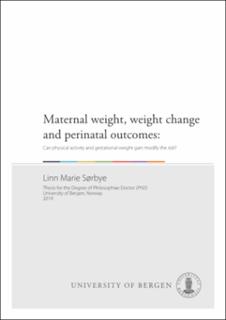| dc.description.abstract | Background: Maternal overweight and obesity increase the risk of complications during pregnancy and childbirth and are a threath to reproduction. It is of major importance to identify factors that have the potential to reduce the risk of perinatal complications associated with maternal overweight and obesity.
Aims: (I) To investigate the association between maternal prepregnant body mass index (BMI) and perinatal mortality, and further to evaluate if physical activity during pregnancy modifies the association. (II) To investigate the risk of gestational diabetes mellitus (GDM) in second pregnancy by change in prepregnant BMI from first to second pregnancy, and whether BMI in first pregnancy and gestational weight gain (GWG) in second pregnancy modify the risk. (III) To estimate the association between weight change from first to second pregnancy and recurrence of GDM.
Material and Methods: (I) We analyzed 77,246 singleton pregnancies in the Norwegian Mother and Child Cohort study (1999-2008), with linked data from the Medical Birth Registry of Norway (MBRN). (II) In data from the MBRN we investigated 24,198 mothers with first and second pregnancies during 2006-2014, without GDM in first pregnancy. (III) Recurrence risk of GDM was analysed in 2,763 women with GDM in their first pregnancy, and who delivered their first and second child during 2006-2014 in the MBRN and 1992-2010 in the Medical Birth Registry of Sweden.
Results: (I) An increased risk of perinatal death was seen in obese (odds ratio (OR) 2.4, 95% CI (confidence interval) 1.7–3.4) and morbidly obese (OR 3.3, 95% CI 2.1– 5.1), as compared to normal weight women. In the group participating in physical activity during pregnancy, obese women had an OR of 3.2 (95% CI 2.2–4.7) for perinatal death relative to non-obese women. In the non-active group the corresponding OR was 1.8 (95% CI 1.1–2.8) for obese women, compared with nonobese women. (II) Compared to women with stable BMI (-1 to 1 BMI units’ change), women who gained weight between pregnancies had higher risk of GDM: Gaining 1 to 2 BMI units: relative risk (RR) 2.0 (95% CI 1.5-2.7), 2 to 4 units: RR 2.6 (95% CI 2.0-3.5), and ≥4 units: RR 5.4 (4.0-7.4). Risk increased both for women with BMI <25 and ≥ 25 in first pregnancy, although more strongly for the former group. Overweight/obese women with an interpregnancy weight loss above 2 units had a 60% lower risk of GDM (RR 0.4, 95% CI: 0.2-0.8). GWG in second pregnancy did not modify the association. (III) Among women with overweight/obesity, recurrence risk of GDM decreased in those who reduced their BMI by 1-2 units (RR 0.80, 95% CI 0.65-0.99) and >2 units (RR 0.72, 95%CI, 0.59-0.89), and increased if their BMI increased by >4 units (RR 1.26, 95%CI 1.05-1.51), compared to those with stable BMI. Among women with BMI<25, the risk of GDM recurrence increased if their BMI increased by 2-4 units (RR 1.32, 95%CI 1.08-1.60) and ≥4 units (RR 1.61, 95%CI 1.28-2.02).
Conclusions: (I) Prepregnant obesity was associated with a two- to three-fold increased risk of perinatal death when compared with normal weight. For women with BMI below 30, the lowest perinatal mortality was found in those performing physical activity, however, for obese women the lowest risk was found in the nonactive group. (II) The risk of GDM in second pregnancy increased by increasing interpregnancy weight gain, and more strongly among women with BMI <25 in first pregnancy. Overweight/obese women with an interpregnancy weight loss, had a 60% lower risk of GDM. (III) Weight loss >1 BMI unit from first to second pregnancy reduced the risk of GDM recurrence by 20-28% in overweight/obese women. Weight gain between pregnancies increased recurrence of GDM in both normal and overweight/obese women.
Implications: Prepregnant BMI and interpregnancy weight change are both important to perinatal outcomes. A population strategy approach should promote healthy weight in the reproductive population from before conception and throughout the interpregnancy window. Overweight/obese women with GDM in first pregnancy, should be systematically followed up to regain a healthy weight prior to their second pregnancy. Further research on physical activity in obese women is warranted, to evaluate if guidelines on physical activity may need to be customised to obese women. In order to evaluate the role of GWG, weight at the time of the GDM diagnosis should be systematically registered in the medical birth registries. | en_US |
| dc.relation.haspart | Paper III: Sorbye LM, Cnattingius S, Skjaerven R, Klungsoyr K, Wikström AK, Kvalvik LG, Morken NH. Interpregnancy weight change and recurrence of gestational diabetes mellitus: a population-based cohort study. BJOG. 2020;127(13):1608-16. The article is available at: <a href="https://doi.org/10.1111/1471-0528.16364" target="blank"> https://doi.org/10.1111/1471-0528.16364</a> | en_US |

